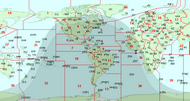30 Ham Radio Contest Tips -- Use a Grey Line Map
 This month, I’m providing a ham radio contest tip-a-day (along with other posts) to help you trigger your own contesting activities. Today’s tip: Use a grey line map.For those who may be new to ham radio or propagation, the grey line is the area on the earth where the time is between day and night. This time period, longer at the poles, less at the equator, is both a wonderful propagation time and the time of transition between bands.Knowing where the grey line is at the moment -- using a great visual tool such as a grey line map -- is a great accessory to have for a contest.Depending upon where we are at in the sunspot cycle, ten meters can go from open to closed as soon as darkness hits or 160 meters can be open across the planet during the grey line and shut down to a chorus of static as soon as the sun comes over the horizon.The grey line itself has many interesting, and perhaps still unknown, propagation characteristics as well. Signals travel further, are louder, and are geographic specific while in the grey line.Consequently, in a contest the time between day and night or night and day is a big time of transition -- and tough decision-making. Is the grey line running through our QTH and a distant multiplier that we need on 80-meters? Do I try and stay on 80-meters to see if a multiplier will be heard or do I shift to 20-meters and work the run? How should I use my second radio? How strong will the band open after the sun comes up? Should I try a higher band first?This is classic contesting strategy: where on the bands should I be to maximize my score? The grey line work -- for multipliers, for when to shift bands, for how the radio(s) are used -- is one of the critical tasks for the contester to learn. And a grey line map is a great help in making those decisions.Scot, K9JY
This month, I’m providing a ham radio contest tip-a-day (along with other posts) to help you trigger your own contesting activities. Today’s tip: Use a grey line map.For those who may be new to ham radio or propagation, the grey line is the area on the earth where the time is between day and night. This time period, longer at the poles, less at the equator, is both a wonderful propagation time and the time of transition between bands.Knowing where the grey line is at the moment -- using a great visual tool such as a grey line map -- is a great accessory to have for a contest.Depending upon where we are at in the sunspot cycle, ten meters can go from open to closed as soon as darkness hits or 160 meters can be open across the planet during the grey line and shut down to a chorus of static as soon as the sun comes over the horizon.The grey line itself has many interesting, and perhaps still unknown, propagation characteristics as well. Signals travel further, are louder, and are geographic specific while in the grey line.Consequently, in a contest the time between day and night or night and day is a big time of transition -- and tough decision-making. Is the grey line running through our QTH and a distant multiplier that we need on 80-meters? Do I try and stay on 80-meters to see if a multiplier will be heard or do I shift to 20-meters and work the run? How should I use my second radio? How strong will the band open after the sun comes up? Should I try a higher band first?This is classic contesting strategy: where on the bands should I be to maximize my score? The grey line work -- for multipliers, for when to shift bands, for how the radio(s) are used -- is one of the critical tasks for the contester to learn. And a grey line map is a great help in making those decisions.Scot, K9JY